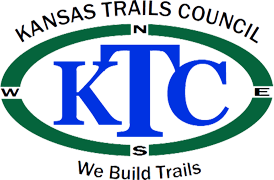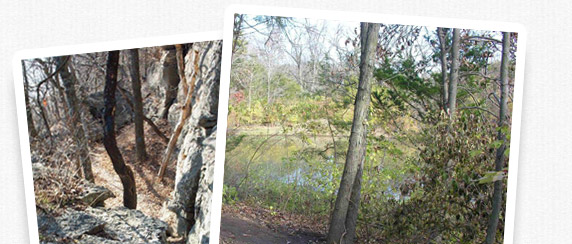What are sustainable trails?
Sustainable trails are trails which are designed to require minimal maintenance and resist deterioration from the elements and from usage.
Why build sustainable trails?
Building sustainable trails minimizes the impact on the natural setting, significantly reduces maintenance, reduces or eliminates erosion and provides a more natural experience for the trail user.
What are some basic construction guidelines for building sustainable trails?
– Maintain a trail grade of 10% or less.
– Keep the trail grade under 1/2 of the adjacent side slope grade.
– Maintain a 3-5% outslope in the trail tread.
Where can I obtain assistance in building sustainable trails?
The Kansas Trails Council’s trail coordinators and members have many years experience building trails in Kansas and would be pleased to answer any questions you may have. You may contact us by clicking this link or contacting a trail coordinator at any of our trails.
What are single track trails?
Single track trails are mountain bike trails that have a tread 16 to 18 inches in width, a sufficient width to allow one trail user at a time. The trail corridor for single track trails is usually 6 to 10 feet wide in order to allow trail users enough room to pass and to permit efficient trail maintenance.
Where can I obtain more detailed information about building single track trails?
For published single track trail building guidelines please explore the IMBA website and watch this trail building video. The trail building concepts in this video apply to all types of natural surface trails. IMBA publications that provide a wealth of trail building information include:
– Trail Solutions: IMBA’s Guide to Building Sweet Singletrack
– Managing Mountain Biking: IMBA’s Guide to Providing Sweet Riding
Where can I find information about building equestrian trails?
Published guidelines for equestrian trail design and construction can be found in the US Forest Service’s Equestrian Design Guidebook for Trails, Trailheads and Campgrounds.
Additional equestrian trail building information can be found on the Back Country Horsemen of America website.
Where can I find information about hiking trail design, building and maintenance?
Three other publications have emerged over the years as leading resources for hiking trail design, building and maintenance:
– Lightly on the Land: the SCA Trail Building and Maintenance Manual
– Appalacian Mountain Club’s Complete Guide to Trail Building and Maintenance
– Appalacian Trail Design, Construction and Maintenance
Where can I find other trail building resources?
Many Forest Service publications can be viewed or downloaded on-line or ordered by mail.
How do I record a GPS track of my trail?
If you would like to learn the basics of creating gps tracks click here.
Many of today’s smart phones have apps that also record gps tracks. Most are quite simple to operate and do not require having a separate gps device. Here are a few apps that may be useful:
MapMyHike
MapMyRide
MyTracks
RunKeeper
A gps track may be displayed on many on-line or off-line software. GPS files can be converted from gpx to kml format for viewing on Google Earth using various website tools
What are the benefits of building multi-use trails?
With the limited availability of public lands upon which to build trails, multi-use trails provide more opportunities for trail users to enjoy Kansas’ natural settings. Multi-use trail information can be obtained from American Trails.
What are “fall line” trails?
Fall line trails are trails that go straight up a slope. Fall line trails are not sustainable and will erode quickly because water will flow swiftly down the slope. Any trail grade that exceeds 1/2 of the side slope grade will erode like a fall line trail because water will tend to funnel onto, then down the steep trail as the least path of resistance. Properly constructed sustainable trails will allow water to sheet gently across and off the trail rather than down the trail.
Can trails be damaged by using them when they are wet or muddy?
Some trail users enjoy getting a little muddy, hiking, running or riding on wet trails, especially in warm weather. However, using trails when they are wet can cause significant damage to the trail tread. Impressions made by feet, hooves or bike tires create places to hold water. This traps water on the trail and delays drying of the trail tread. The longer the trail tread remains wet, more trail users will leave more impressions which hold more water and so on. Damage to the trail tread created in minutes by a single trail user during wet trail conditions may take hundreds of hours of work to repair. Please remember to let the trails dry out. Your local volunteer trail builders will thank you!

